ASX: ROC - Our new Investment
Disclosure: S3 Consortium Pty Ltd (the Company) and Associated Entities own 6,575,000 ROC shares and the Company’s staff own 125,000 ROC shares at the time of publishing this article. Some shares are subject to approval in an upcoming EGM. The Company has been engaged by ROC to share our commentary on the progress of our Investment in ROC over time.
Our new Portfolio addition is RocketBoots (ASX:ROC).
ROC has developed “Vision Artificial Intelligence” technology for giant companies to analyse and respond to in-store customer behaviours.
It is currently in use by TWO major, household name companies...
(who have both renewed and expanded their usage of ROC’s tech over many years, proving that the product works and is useful).
$12M capped ROC has ~$35M revenue in their “advanced stage sales pipeline” (our calcs shown below).
Our bet is that if ROC can sign one or more new deals in the near term it could multiply ROC’s current ~$700k FY24 revenue.
...and materially re-rate the ROC share price.
Over the last few years we have had a pretty good run with our ASX tech stock Investments:
- OneView Healthcare (ASX: ONE) - Up ~858% at its peak from our Initial Entry Price.
Currently 383% above our Initial Entry Price.
- AML3D (ASX: AL3) - Up ~306% at its peak last year from our Initial Entry Price.
Currently 158% above our Initial Entry Price.
- EchoIQ (ASX: EIQ) - Up ~120% at its peak last year from our Initial Entry Price.
Currently 93% above our Initial Entry Price.
The past performance is not and should not be taken as an indication of future performance. Caution should be exercised in assessing past performance. This product, like all other financial products, is subject to market forces and unpredictable events that may adversely affect future performance.
We like ROC because of its mature, proven technology, in use by multiple long-term paying customers...
(including household names like Bunnings and Suncorp Bank, source)
AND because of long sales cycles and a stale shareholder base, our view is that the broader market is not properly valuing ROC’s mature and proven vision AI tech OR the potential of a near term increase in sales revenue...
(similar to why we liked ONE and AL3)
We also like that ROC started developing its AI (artificial intelligence) way before AI became the hottest investment theme in recent memory
(same reason we liked EIQ).
Companies developing genuine AI with over a decade of development efforts AND internal knowledge on how to apply AI to solve a specific and real world problem are rare on the ASX...
And in our view are the best positioned to leverage and apply the rapid recent advances in AI technology and tools to their specific sector of expertise.
ROC’s vision AI technology lets giant companies analyse and respond to in-store customer behaviours.
Think giant companies like major supermarkets, banks, retailers and food franchises.
Any massive operation with millions of customers physically coming in and out of their stores or buildings every day.
Most (if not all) of these companies will have security cameras to monitor their stores.
ROC’s tech analyses real time store camera footage and applies AI to improve performance in workforce management, customer service, and loss prevention.
Currently there are two main reasons ROC is used by its customers.
First, ever get annoyed waiting in (or even just seeing) a queue at a shop?
Enough to just leave and not spend your cash?
ROC can analyse and reduce queue times in retail shops, bank branches, coffee and food shops (basically any shopfront where queues form):

This improves customer experience and reduces lost revenue.
Which quickly adds up for large companies with thousands of stores and big revenue numbers.
(last week ROC announced a major Australian bank extended its use of ROC across more of its bank branches - a $214k per year contract for two additional years - ROC announcement)
Secondly...
Most major supermarkets have rolled out self service checkouts to save on staff costs.
PROBLEM: Theft has increased by 122%, leading to billions of dollars in lost products/income.
ROC’s tech reduces theft and loss at self checkouts better than current manual methods.
ROC can instantly detect a theft, missed scan, incorrect scan at a self checkout....
and immediately notify the customer of the, ahem...“mistake” and allow them to quietly correct it by pressing a button.
No need to get any staff or security involved - saving staff time AND cost of theft.

ROC is targeting ~450,000 retail sites across Australia, Europe and the US and with a total addressable market up to ~US$2.3BN per year.
The big news from last week: ROC signed a partnership with a German company called Gebit, which is a major seller of self checkout technology globally - read this ROC Announcement.
(Gebit has some big customers by the way, more on that in a moment)
Point is, ROC’s product is already built and mature, has over a decade of genuine AI development built in and it is in use right now by multiple, paying and renewing customers.
(meaning the product works and customers like it enough to renew / keep paying for it)
ROC’s two biggest clients are Bunnings and Suncorp Bank.
So a major bank AND a major retailer have been using AND renewing ROC’s product for many years... AND expanding usage across more sites.
(Bunnings is owned by Wesfarmers, an $82BN ASX listed conglomerate that also owns other big retail brands including Kmart, Target, Officeworks, Priceline Pharmacy... wonder if one day they will also be interested in ROC’s technology?)
This is one of the key reasons that initially got our attention - validation that ROC’s product works and is valued by its users.
We have Invested in ROC to see it grow its customer base (and revenue) - ideally quickly.
ROC charges $3,500 per year per site for its technology (source, ROC investor deck slide 10).
ROC has ~8 companies with up to 10,000 sites across their businesses in its “Advanced Stage Pipeline”.
(according to their October 2024 investor deck - source, slide 10)
By our rough, basic calcs that could be ~$35M license revenue, ignoring bulk purchase discounts and set up fees.
FOUR of these companies were shown at the “scaled site contract negotiation” stage... surely they must be close by now?
ROC also shows 18 companies for a total of 23,000 sites in its “Early Stage” sales pipeline for a rough, basic calculation of ~$80M revenue
(again a basic $3,500 per site per year times number of sites ‘back of the napkin” calculation, ignoring any discounts and setup fees)
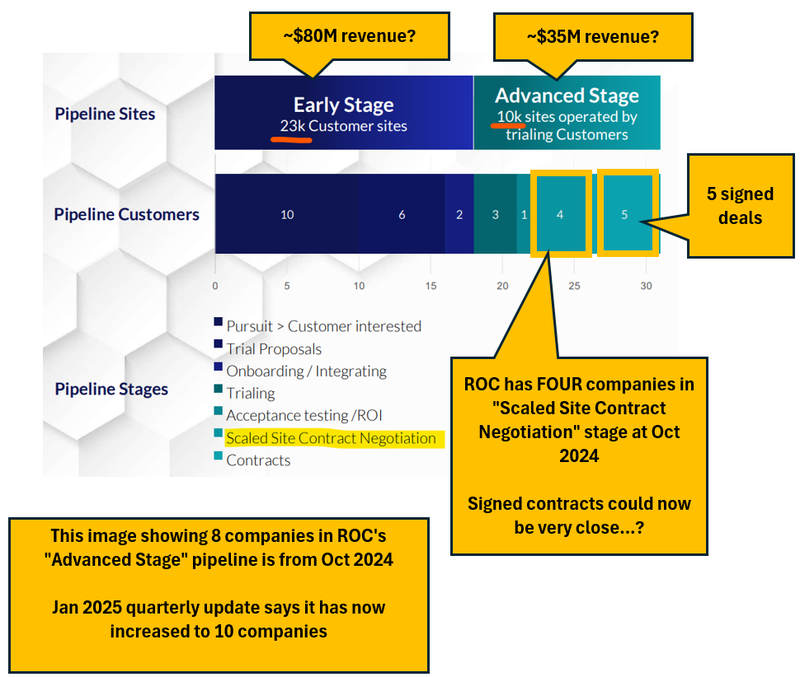
(Source, Investor Presentation Oct 2024)
According to the most recent ROC quarterly from January 2025, the number of deals in the advanced stage pipeline has now increased from 8 to 10. (source)
And that there are also “3 large multinational customers” - which means the deal sizes could be large.
Even if just 10% of that “advanced stage” pipeline is converted it would be ~3.5x ROC’s current revenues.
Our bet is that if a few of the big deals in the “Advanced Stage” pipeline are signed, it will transform the ~$12M ROC’s valuation to multiples of where it is today.
We think that any major contract signing has the potential to multiply that market cap very quickly...
We like tech stocks because of that “hockey stick” style growth potential - and we are betting that with one (or more) large signed deal in the near term ROC can achieve this:
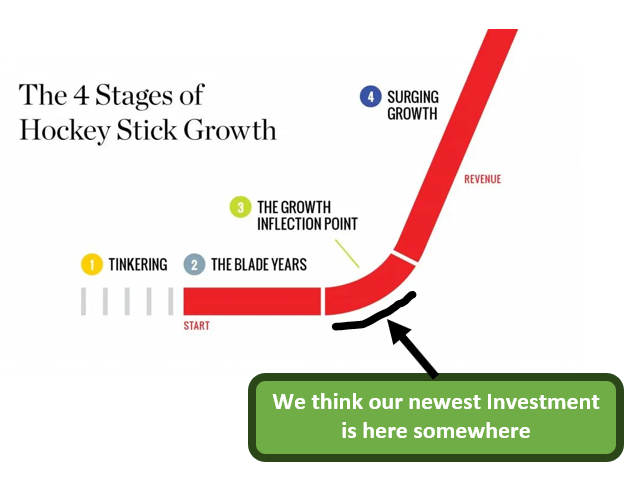
Of course, the above growth looks great but success can take longer (sometimes much longer) than expected... or never actually eventuate.
The hard part is timing...
Obviously everyone (including us) wants to jump on just as the hockey stick growth is about to start.
And every tech company pitch deck we see says it’s “just about to start”.
But ultimately it’s down to whether the company actually delivers the deals and revenue growth in the near term - on which we can form an opinion and take a position, but can’t control.
Sometimes you can time an entry just right... which we hope we are doing here with ROC.
But early stage tech investing also comes with risks including that deals and revenue take longer than expected (we outline the key risks we have identified and accepted with this Investment later in this note).
Today, we will be going in detail as to:
- The 8 key reasons why we are Investing in ROC
- Explain what ROC sells and who it sells it to...
- Explain the risk-reward “Bet” on ROC
- Release our new ROC Investment Memo
8 key reasons why we are Investing in ROC:
- ROC already has long term, paying enterprise customers including Bunnings and Suncorp.
Both Bunning (large DIY goods retailer owned by Wesfarmers) and Suncorp (community bank owned by ANZ) are paying customers of ROC.
They have been customers since before ROC’s December 2021 IPO and continue to renew and expand their licence contracts 7+ years later.
This is strong evidence that ROC can sell its product to enterprise customers, and that those customers find long term value out of the service. - Over ~$35M in potential annual recurring sales from “advanced stage deal pipeline”
According to ROC’s most recent quarterly report, ROC had 10 customers in its “Advanced Pipeline”.
These customers represent over 10,000 sites in total.
At $3,500 per site per year, by our rough, basic calcs this represents over $35M in potential annual recurring revenue if ROC is able to convert into sales.
(using a basic $3,500 per site per year times number of sites calc, ignoring bulk discounts and setup fees)
Even if just 10% of that “advanced stage” pipeline is converted, it would be 3.5x ROC’s current revenues. - One large deal could multiply ROC’s current revenue
If ROC is able to sell to a large multinational contract it could have its product in thousands of stores through just one deal.
At a price point of $3,500 per store one deal could be in the millions of dollars in recurring free cash flow.
These deals take a very long time to secure (as do most enterprise software deals).
ROC has shown that its enterprise customers tend to be incredibly “sticky” (stay on for a long time) - Partnership with Europe’s largest Point of Sale company: Gebit Solutions
Gebit Solutions sells self checkouts to supermarkets and retailers.
Gebit is the point of sale system for some of the largest supermarket retailers in Europe and Gebit will now support an “out of the box integration” with ROC’s software.
High-synergy partners like Gebit help improve ROC’s reputation to enter the conversation with big retailers, despite ROC being a smaller player in the space. - Original founding team still in place, with a new experienced tech chairman at the helm
The original team that developed ROC’s technology in the early 2010s are still running the company (including the CEO and CTO).
This is a positive sign for tech startups when a long term founding team has been working on the product for 10+ years.
Now however, ROC has a new chairman with experience in both private equity and tech enterprise sales.
ROC’s new chairman Roy McKelvie is also the chairman of an education technology company called Pathify that he helped to scale and raise US$25M at a A$180M valuation.
Roy invested $200,000 personally into ROC last year at 8.5 cents and a further $90,000 in the current placement. - Genuine AI and deep knowledge of how to apply AI to a specific problem
ROC’s AI and machine learning technology has been developed since 2010.
(well before AI became big Investment theme)
Companies developing genuine AI with over a decade of development efforts AND internal knowledge on how to apply AI to solve a specific and real world problem are rare on the ASX
And in our view are the best positioned to leverage and apply the rapid recent advances in AI technology and tools to their specific sector of expertise. - Vision capture technology valued in the US$250M-$500M range
In late 2022 a company called Trigo raised US$100M off the back of its grocery vision software.
In 2023 one of the largest companies in this space Everseen raised US$70M to advance a very similar technology.
Those large raises are evidence of the size of the opportunity in this space that investors are seeing.
If ROC is able to deliver more sales and capture market share, it could grow to the size of these larger competitors in the space. - ROC has a good capital structure with strong ownership represented in board and management
Following today’s capital raise news and its completion, ROC will have 154 million shares on issue.
The major shareholders are the original vendors of the technology and have proven to be sticky since the IPO.
The board and senior management represent ~44% of the shares on issue prior to this recent capital raise, which means they are very aligned to shareholders interests.
Who are ROC’s customers?
ROC is targeting ~450,000 retail sites across Australia, Europe and the US and with a total addressable market up to ~US$2.3BN per year.
Its existing clients are established, major brands... including Bunnings and Suncorp Bank.
ROC’s revenue in FY24 was ~$730K.
We like tech companies where “one big deal” can change the fortunes of the company.
Think ONE, EIQ, AL3...
ROC has two main verticals
- Supermarket Retailers - Retail grocery stores operate on incredibly thin margins (around 2.2% profit on each item sold). Theft and other inventory loss accounts for 1.33% in lost revenue. Solving this challenge will have a $132BN impact on the bottom line of the supermarket industry just in the US.
- Retail Banks - ROC’s workflow management tool helps banks make staffing more efficient within the physical branch. With a reduced cost of operations banks can keep region branches open either as a market share play or defensively to retain customers.
One of the big reasons that we liked ROC was its pipeline of customers...
According to ROC’s most recent quarterly report ROC had 10 customers in its “Advanced Pipeline”.
These customers represent over 10,000 sites.
At $3,500 per site per year, this pipeline represents over $35M in potential Annual Recurring Revenue if ROC is able to convert into sales.
Even if just 10% of that pipeline is converted it would be 3.5x ROC’s current revenues.
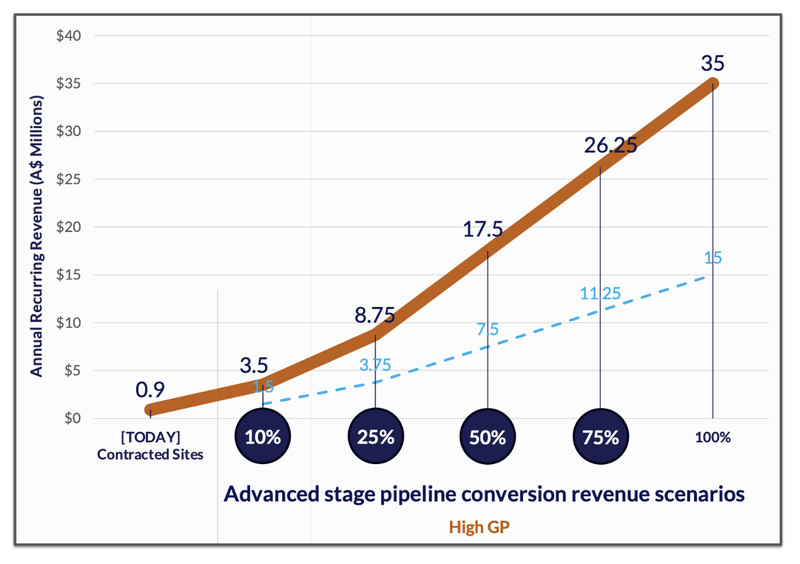
In ROC’s favour is that the customers that do use ROC’s product, continue to renew the licence year on year...
Both of its biggest customers Bunnings and Suncorp were ROC customers before its IPO in 2021.
And both recently renewed their contracts with the company.
ROC just raised $3M. New chairman has enterprise tech sales experience
ROC just completed a raise of $3M, at 8 cents.
After the capital raise ROC will be valued at just ~$12M and have a further $3M in the bank to extend its cash runway and deliver on some key sales milestones.
As part of our due diligence on the ROC, we have met the founder of the company Joel Rappolt, who has been working on the product since 2007.
We also met the new Chairman, Roy McKelvie, who has a strong track record of delivering enterprise software sales.
Roy is also the chairman of an education technology company called Pathify that he helped scale and raise US$25M at a A$180M valuation.
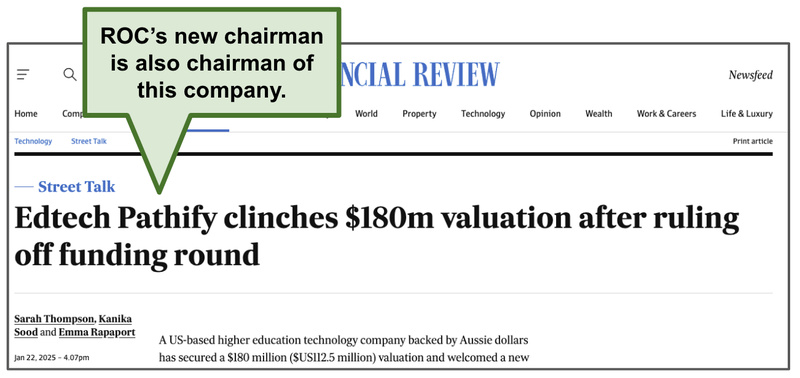
Last year, Roy invested $200,000 personally into ROC at 8.5 cents and a further $90,000 in the current placement.
Having someone like Roy, who has proven enterprise sales experience, was one of the key reasons why we Invested in ROC.
We think that Roy’s understanding of enterprise sales and ability to market and package the technology to large organisations will be extremely beneficial to ROC.
On that note, ROC recently signed a big collaboration deal with one of the largest point of sales companies in Europe.
ROC signs partnership deal with largest “point of sale” company in Europe
Last week ROC announced that it had signed a partnership agreement with the largest supermarket point of sale system in Europe.
(the company is called Gebit Solutions)
Here is Gebit’s social media team announcing the partnership:
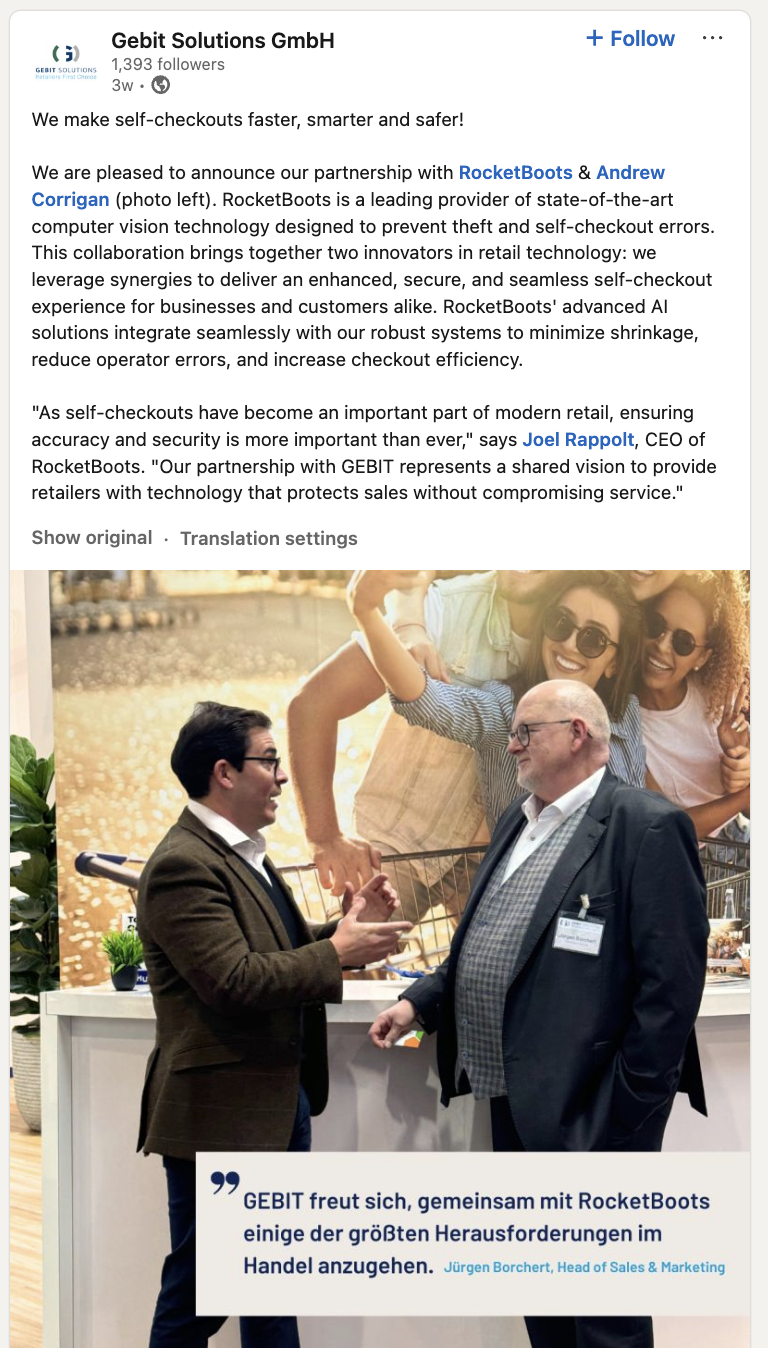
In the ASX announcement ROC mentioned that Gebit will support an “out of the box integration” with ROC’s software.
This is a big deal as it will reduce the friction (and also work as an endorsement) of ROC’s software.
High-synergy partners like Gebit provide ROC with the necessary clout to enter the conversation with big supermarket chains, despite being a much smaller player in the space.
It is a testament to ROC’s technology that Gebit chose it as its “preferred supplier of loss prevention” software.
There are some big logos on Gebit’s website that represent thousands of retailers across Europe, the US and Australia.
(just these brands alone would have 10,000+ stores across Europe and the US)

What is ROC’s business model?
ROC has a traditional software as a service (SaaS) business model.
It has spent years developing a technology that it sells to capture and interpret video images from security camera footage.
Our bet is that if ROC can continue to make more sales at scale then it could generate some significant free cashflow which it can re-invest into the business to scale further and grow market share.
ROC is currently focused on two key verticals:
- Supermarkets/Retail Stores
- Banks
To get an understanding of ROC’s potential market size here is a breakdown from one of its investor presentations from last year:
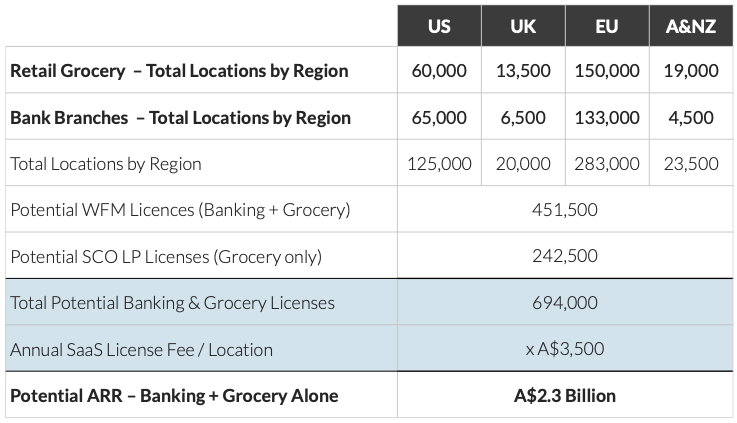
(Source, Investor Presentation May 2024)
ROC already has brand name customers using its product, it is now time for ROC to scale up its business and capture a larger portion of this potential market.
ROC’s first target vertical: Supermarket/Retailers
Supermarkets and retail are all about loss prevention.
Large supermarket chains like Coles, Woolworths and Walmart tend to work on very thin margins.
On average, grocery stores make about 2.2% profit on each item sold (source).
So if ROC is able to save a company even a fraction of a %, then it could have a meaningful impact on the organisation at scale.
Over the past few years large supermarkets have implemented self-checkouts to reduce staff overheads.
This has been very successful in terms of customer experience but has created a new problem across the stores called “shrinkage”.
Shrinkage = any inventory loss (other than sales), such as shoplifting, employee theft, administrative errors, spoilage, or damage.
In 2017 shrinkage cost retailers US$47BN or 1.33% of revenue (Source).
By 2024, with the rollout of self-checkout in full swing, that number has ballooned to US$132BN in the US. (Source)
That number should only grow as time wears on and more stores around the world shift to automated and self-serve processes.
With high-volume, low-margin businesses like supermarkets, reducing the shrinkage will have a meaningful impact on profitability.
Who are ROC’s top retailer customers?
Recently, Bunnings renewed its contract with ROC, proving that its technology is valuable to the organisation.

As per ROC’s prospectus - this “Major Australian Retailer” is in fact Bunnings. (Source)

(Source - ROC Prospectus, p.130)
Bunnings is owned by Wesfarmers and is known as a “superstore”.
“superstores” are the big box retailers, brand names that are well recognised in their respective countries.
There are ~1M “superstores” around the world. (Source)
Increasingly, shopping for groceries and other household products is being done at large centralised locations.
In Australia alone there are roughly ~2,400 of these types of stores. (Source)
Superstores move slowly to make decisions as the choice of vendor is very important.
So selling into these large organisations requires a long sales cycle.
But once a preferred supplier has been chosen the contract tends to be very sticky given the large amount of due diligence that goes into these purchasing decisions.
It has only been a handful of years since retailers have moved to a self-checkout system... and now the focus is on loss prevention, where ROC has the solution.
ROC also offers a “workforce management” tool
Together with its loss prevention tool, ROC sells a workforce management tool to both banks and retailers.
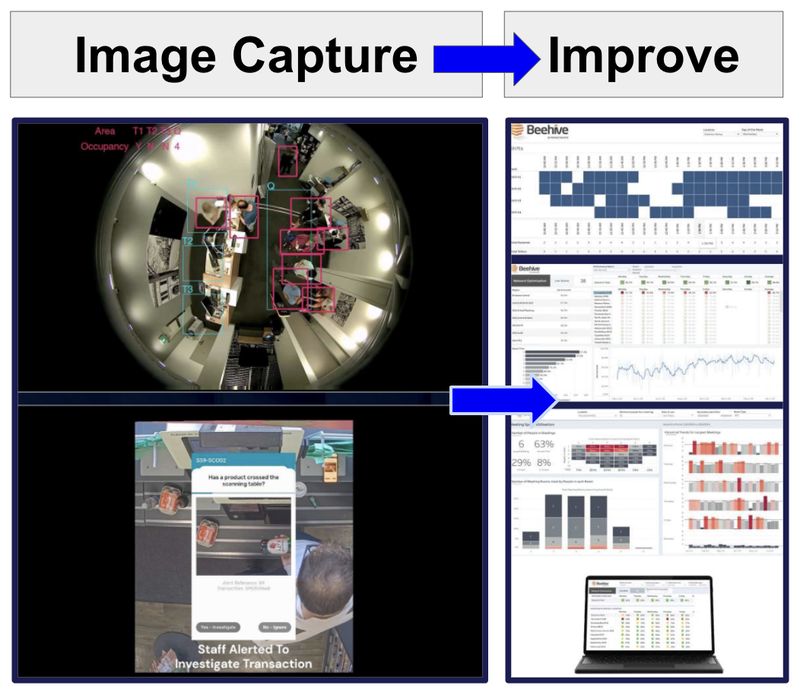
But why is it so important for banks?
These days, less people come into a physical bank branch, and banking is moving digital.
However, banks have realised that closing branches (particularly in remote areas) will cause them to lose customers - particularly older customers that stick to the same bank for years and like to do their banking in person.
In order to justify re-opening these branches banks are trying to run them more efficiently, as almost a play to capture more market share in the business.
That is where ROC comes in.
By making things more efficient within the branch, a bank like NAB (for example, not a ROC client) can justify opening new branches either as a market share play or defensively against new banks opening.
(NAB announced in November last year that it would be opening new physical branches).
ROC already has a deal with a bank which is Suncorp:
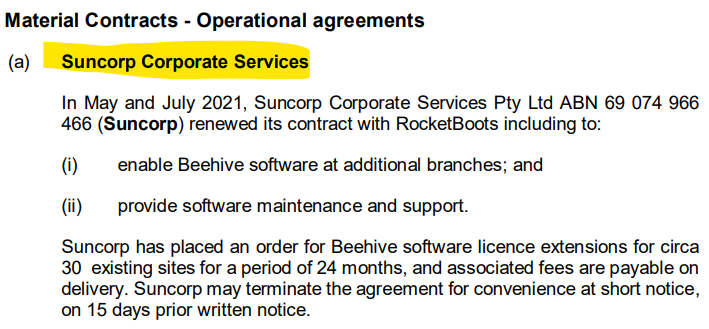
(Source - ROC Prospectus, p.130)
Breaking down the “bet” for ROC
This is how we are breaking down the “bet” on ROC; there are two questions to be evaluated:
- Will ROC be able to close multiple big enterprise sales in the future?
- If they can, is the prize big enough to justify the risk of ROC not closing the sales?
Why YES... ROC’s team can close multiple big sales:
- The new chairman knows enterprise tech sales. Roy has had experience in enterprise tech sales and is more hands-on than the previous chairman.
- Customers already like the product. ROC has multiple paying enterprise customers that have renewed the product (including Bunnings). This is validation that the ROI of buying the product is enough to justify the cost.
- Partnerships. ROC has a key partnership with a top technology vendor that is in tens of thousands of supermarkets across the world: Gebit Solutions.
- Time. There has been 4+ years of building relationships with key customers and 10+ years of developing the product.
- Value proposition becoming more relevant to the customers:
- Self checkout is reducing headcounts for supermarkets but increasing theft, affecting a key part of the bottom line.
- Brick and mortar bank branches are now re-opening to capture market share, but are not very cost efficient.
Risk: Why NOT... ROC’s team can’t (or takes too long) to close sales:
- Turnover of key decision makers. When working on big contracts the turnover of key staff can set back deals months (and even years). This is a big challenge that ROC will need to overcome.
- IF the technology is easy to replicate ROC could be at risk. AI and facial recognition software is growing rapidly, so ROC needs to ensure that its product is (1) better than competitors and (2) better than what the customer can create themselves.
- Sales competition. The largest company in this space is called Everseen. Everseen has a valuation of ~US$250M - $500M according toDeal Room and recently raised€65M in 2023. Everseen has a head start both in financial power and market share. ROC will need to be more agile to win big deals against Everseen.
If ROC’s business succeeds, what is the size of the prize?
ROC is capped at just $12M at the last raise price.
If it is able to sell to a large multinational supermarket it could have its product in thousands of stores through just one deal.
At a price point of $3,500 per store one deal could be in the millions of $ in free cash flow.
But what could the company be worth?
In late 2022 a company called Trigo raised US$100M off the back of its grocery vision software.
And in 2023 one of the largest companies in this space raised US$70M to advance a very similar technology.


ROC’s value, if it is able to secure multiple stores and multiple sites, could grow to the size of its larger competitor Everseen - which was most recently valued at US$250M - US$500M.
It also will become a very attractive takeover target if the company is able to secure multiple high-value customers and integrate its software into their systems and workflow.
If ROC is unable to make sales, or sales are delayed, then it will likely need to raise more capital on market at lower and lower prices - diluting existing shareholders in the meantime.
This the risk-return “bet” for ROC... and we think that at $12M it is attractive enough of a market cap entry price to make that bet.
Investment Memo: RocketBoots (ASX:ROC)
Memo Opened: 31st March 2025
Share at Open: 6,575,00
What does ROC do?
ROC has developed “Vision Artificial Intelligence” technology for giant companies to analyse and respond to in-store customer behaviours.
ROC’s main customers today are retail supermarkets and commercial banks to help optimise workforce management and alleviate loss prevention.
What is the macro theme behind ROC?
In-store shopping behaviours are moving to “autonomous”.
With self-checkout and self-ordering systems stores are putting the control back into the customers’ hands.
The challenge is that this has led to an increased amount of loss and theft for the retailers, and requires highly advanced monitoring software to sustain.
What is our Big Bet for ROC?
“ROC re-rates to a $200M market cap by securing multiple large recurring contracts with retail clients and scaling up its business”
The 8 Reasons we Invested in ROC:
- ROC already has long term, paying enterprise customers including Bunnings and Suncorp.
- Over ~$35M in potential annual recurring sales from “advanced stage deal pipeline”
- One large deal could multiply ROC’s current revenue
- Partnership with Europe’s largest Point of Sale company: Gebit Solutions
- Original founding team still in place, with a new experienced tech chairman at the helm
- Genuine AI and deep knowledge of how to apply AI to a specific problem
- Vision capture technology valued in the US$250M-$500M range
- ROC has a good capital structure with strong ownership represented in board and management
What are the key objectives we want to see ROC achieve?
New Sales: Retail/Supermarket
🔲 New customer 1
🔲 New customer 2
🔲 New customer 3
New Sales: Consumer Banks
🔲 New customer 1
🔲 New customer 2
🔲 New customer 3
Existing customer resigns or expands:
🔲 Contract re-sign with Bunnings
🔲 Contract re-sign with Suncorp
What are the risks?
Sales and Delay Risk
ROC could lose key clients or not seal as many deals, hurting their revenue and share price.
Large organisations like the one’s ROC works with don’t tend to adopt new technology very often and the sales cycle can be long. This feature of ROC’s customer base can cause delays in sales that drag out over a long time,
Marco factors in the market including a recession can cause a reduction in spending on new technology, affecting ROC’s ability to make sales.
Technology / Competition Risk
Technology is a competitive market. If ROC’s technology is deemed to be less valuable than other competitors, then it may fail to win sales.
Market risk
Tech stocks could fall in value again. Even if ROC does everything right from an operational standpoint, the market could always sell off or favour different sectors.
Funding Risk
Although ROC just raised $3M, it is still a small cap stock that it is burning more money that it is making.
Based on its existing cash burn this $3M will give the company about 3 - 4 quarters of runway before it will need to raise again.
If the company has not been able to secure a major deal in that time then it may be doing the next raise at a lower valuation.
What is our investment strategy?
We plan to hold a position in ROC for the next 3 to 5 years (and beyond) as it scales up its technology business.
We eventually may look to take some profits by selling up to ~20% of our holding (in line with our holding policy and escrow conditions) if the share price materially re-rates on the company successfully delivering on the key objectives listed above.
General Information Only
This material has been prepared by StocksDigital. StocksDigital is an authorised representative (CAR 000433913) of 62 Consulting Pty Limited (ABN 88 664 809 303) (AFSL 548573).
This material is general advice only and is not an offer for the purchase or sale of any financial product or service. The material is not intended to provide you with personal financial or tax advice and does not take into account your personal objectives, financial situation or needs. Although we believe that the material is correct, no warranty of accuracy, reliability or completeness is given, except for liability under statute which cannot be excluded. Please note that past performance may not be indicative of future performance and that no guarantee of performance, the return of capital or a particular rate of return is given by 62C, StocksDigital, any of their related body corporates or any other person. To the maximum extent possible, 62C, StocksDigital, their related body corporates or any other person do not accept any liability for any statement in this material.
Conflicts of Interest Notice
S3 and its associated entities may hold investments in companies featured in its articles, including through being paid in the securities of the companies we provide commentary on. We disclose the securities held in relation to a particular company that we provide commentary on. Refer to our Disclosure Policy for information on our self-imposed trading blackouts, hold conditions and de-risking (sell conditions) which seek to mitigate against any potential conflicts of interest.
Publication Notice and Disclaimer
The information contained in this article is current as at the publication date. At the time of publishing, the information contained in this article is based on sources which are available in the public domain that we consider to be reliable, and our own analysis of those sources. The views of the author may not reflect the views of the AFSL holder. Any decision by you to purchase securities in the companies featured in this article should be done so after you have sought your own independent professional advice regarding this information and made your own inquiries as to the validity of any information in this article.
Any forward-looking statements contained in this article are not guarantees or predictions of future performance, and involve known and unknown risks, uncertainties and other factors, many of which are beyond our control, and which may cause actual results or performance of companies featured to differ materially from those expressed in the statements contained in this article. S3 cannot and does not give any assurance that the results or performance expressed or implied by any forward-looking statements contained in this article will actually occur and readers are cautioned not to put undue reliance on forward-looking statements.
This article may include references to our past investing performance. Past performance is not a reliable indicator of our future investing performance.

